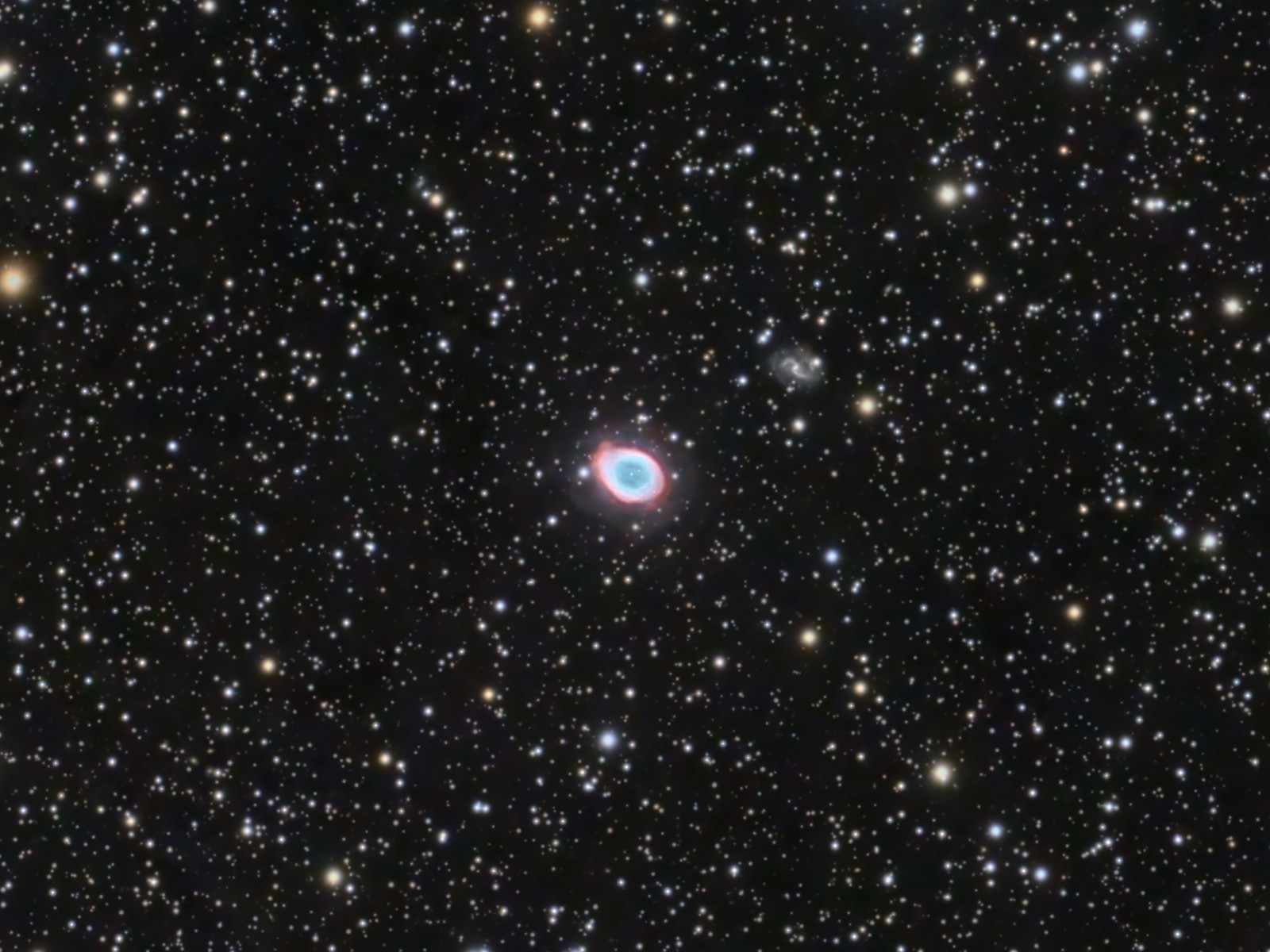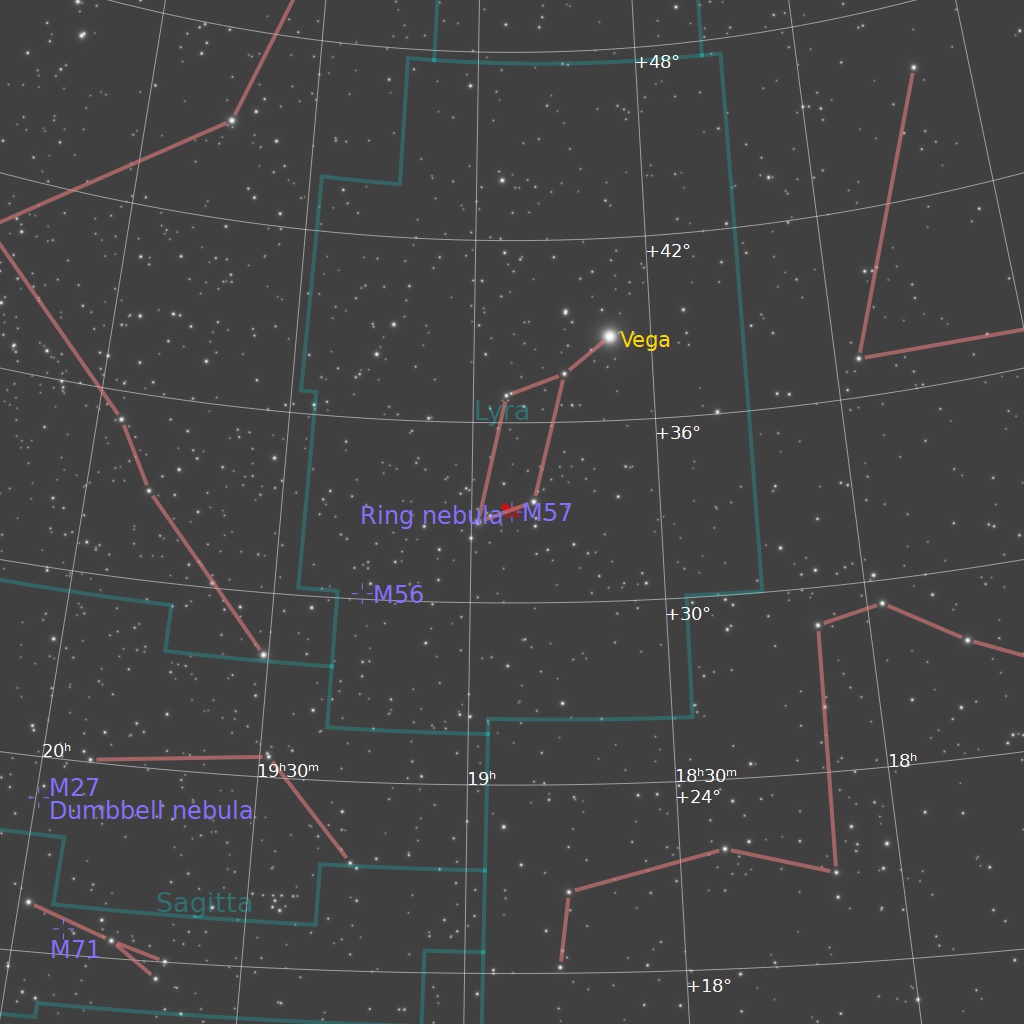M57 – The Ring Nebula
Click image for full size version
September 19, 2022
M57, the Ring Nebula, is one of the first things I looked at visually when I became interested in astronomy. It looked like a cosmic smoke ring in my first decent scope, an 8″ Schmidt-Cassegrain. There are two stars inside the ring that I have seen distinctly only once using my 20″ reflector, and indistinctly just a few times. And yet the brightest part of the ring makes it pretty easy in binoculars (except that it’s small). So bottom line is it’s good with just about any kind of optical aid. Images capture the pretty colours of the nebula and the surrounding stars, and deep images like this one can capture the faint ruffled outer shell. If you have binoculars or a scope, this object is well placed in the evening just after dark, high in the northeast, smack-dab between two bright stars in Lyra. One of these stars is Sheliak, which will be familiar to Star Trek Buffs. See http://en.memory-alpha.org/wiki/Sheliak to find out more about the brutish Sheliak people and their home world.
This planetary nebula is the glowing shell of a dying star, the star in the centre of the ring. The red is mostly from glowing hydrogen atoms, the teal is mostly from glowing oxygen atoms. Photos of M57 over the last 50 years confirm that it is expanding. When your great-great-great-great-great-grandchildren look at it, it will be quite a bit bigger and a lot fainter!
You can’t help but notice the pretty galaxy to the upper right of M57. It’s known as IC 1296, and lies 235 million light years away, far in the background in this image.
Tekkies:
Acquisition, focusing, and control of Paramount MX mount with N.I.N.A., and TheSkyX. Focus with Optec DirectSync motors and controller. Equipment control with PrimaLuce Labs Eagle 4 Pro computer. All pre-processing and processing in PixInsight. Acquired from my SkyShed in Guelph. Very good transparency and average seeing. Acquired June 9-16, 2022, under moonless skies.
Sky-Watcher Esprit 150 f/7 refractor and QHY600M camera with Optolong UV/IR filter
Tak FSQ-106 @ f/5 (530mm), QHY-367C Pro One-shot colour with Optolong UV/IR filter
79x5m OSC = 6hr35m
The WeightedBatchPreProcessing script was used to perform calibration, cosmetic correction, weighting, registration, local normalization and integration of all frames.
DrizzleIntegration was applied to the OSC frames, and the result was aligned to the Luminance master with StarAlignment. This yielded aligned Lum and Colour masters.
DynamicBackgroundExtraction was applied to the Luminance and OSC masters.
Colour
Colour Calibration: ColorCalibration was used to calibrate the OSC master.
Linear Noise Reduction: NoiseXterminator was used to reduce noise in the background areas with settings Amount=0.9 and Detail=0.15
Stretching: HistogramTransformation was applied to make a pleasing yet bright image.
Luminance
Deconvolution: A star mask was made from the Luminance master to use as a Local Deringing Support Image. The GAME script was used to make a mask selecting only NGC 5033 and 5005 for deconvolution. Deconvolution was applied (50 iterations, regularized Richardson-Lucy, ParametricPSF mode with default settings; Global dark deringing = 0.02; Global bright deringing 0.007).
Linear Noise Reduction: NoiseXterminator was used to reduce noise in the background areas with settings Amount=0.9 and Detail=0.25
Stretching: HistogramTransformation was applied to make a pleasing yet bright image.
Combining Luminance and Colour Images
Luminance addition: LRGBCombination was applied to replace the lightness of the RGB image with the Luminance master.
Additional Processing
Star Removal: StarNet v2 was used to remove stars.
Nonlinear Noise Reduction: NoiseXterminator was used to reduce noise in the background areas of each image with settings Amount=0.9 and Detail=0.25
Contrast Enhancement: LocalHistogramEqualization was applied using an inverted lightness mask to protect the background and select the galaxies. Three passes were applied (scale 20, max contrast 1.5, strength 0.5, 1 iteration; scale 80, max contrast 1.5, strength 0.4, 1 iteration; and scale 150, max contrast 1.5, strength 0.18).
Sharpening: MultiscaleMedianTransform was used with the same mask used for Deconvolution to sharpen Layers 2 – 4 with strengths of 0.05, 0.02 and0.01, respectively.
Star Processing and Restoration: Curves was used to boost saturation in the stars. The stars were added back into the image using straight addition in PixelMath.
Final Steps: Background, galaxy and star brightness, contrast and saturation were adjusted in several iterations using CurvesTransformation with masks as required. MorphologicalTransformation was used in Morphological Selection mode to slightly reduce the size of stars. ICCProfileTransformation (sRGB IEC61966-2.1; Relative Colorimetric with black point compensation) was applied prior to saving as a jpg.








Beautiful image, like always!